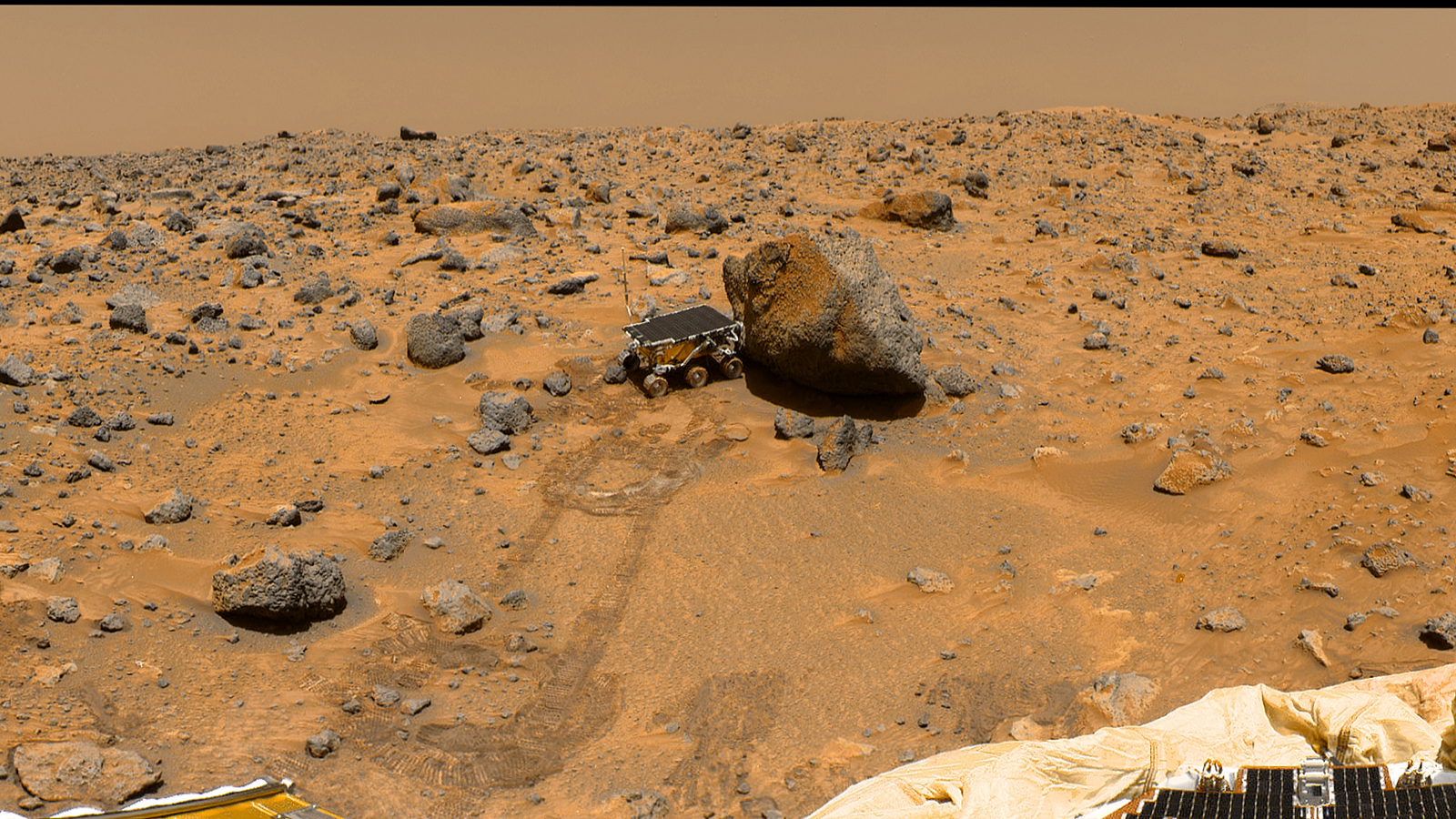Resources
Mars Pathfinder Panorama

Photojournal: PIA01466
An improved, color enhanced version of the 360-degree Gallery Pan taken by Mars Pathfinder in 1997.
This is a more recent "geometrically improved, color enhanced" version of the 360-degree "Gallery Pan," the first contiguous, uniform panorama taken by the Imager for Mars (IMP) over the course of Sols 8, 9, and 10. Different regions were imaged at different times over the three Martian days to acquire consistent lighting and shadow conditions for all areas of the panorama. In this version of the panorama, much of the discontinuity that was due to parallax has been corrected, particularly along the lower tiers of the mosaic containing the Lander features. Distortion due to a 2.5 degree tilt in the IMP camera mast has been removed.
The IMP is a stereo imaging system that, in its fully deployed configuration, stands 1.8 meters above the Martian surface, and has a resolution of two millimeters at a range of two meters. The IMP has color capability provided by 24 selectable filters—twelve filters per "eye." Its red, green, and blue filters were used to take this panorama.
The three color images were first digitally balanced according to the transmittance capabilities of a specific high-definition TV device at JPL, and then enhanced via changes to saturation and intensity while retaining the hue. A threshold was applied to avoid changes to the sky. An MTF filter was applied to sharpen feature edges.
At left is a Lander petal and a metallic mast which is a portion of the low-gain antenna. On the horizon the double "Twin Peaks" are visible, about 1-2 kilometers away. The rock "Couch" is the dark, curved rock at right of Twin Peaks. Another Lander petal is at left-center, showing the fully deployed forward ramp at far left, and rear ramp at right, which rover Sojourner used to descend to the surface of Mars on July 5. Immediately to the left of the rear ramp is the rock "Barnacle Bill," which scientists found be andesitic, possibly indicating that it is a volcanic rock (a true andesite) or a physical mixture of particles. Just beyond Barnacle Bill, rover tracks lead to Sojourner, shown using its Alpha Proton X-Ray Spectrometer (APXS) instrument to study the large rock "Yogi." Yogi, low in quartz content, appears to be more primitive than Barnacle Bill, and appears more like the common basalts found on Earth.
The tracks and circular pattern in the soil leading up to Yogi were part of Sojourner's soil mechanics experiments, in which varying amounts of pressure were applied to the wheels in order to determine physical properties of the soil. During its traverse to Yogi the rover stirred the soil and exposed material from several centimeters in depth. During one of the turns to deploy Sojourner's Alpha Proton X-Ray Spectrometer, the wheels dug particularly deeply and exposed white material. Spectra of this white material show it is virtually identical to the rock "Scooby Doo," and such white material may underlie much of the site. Deflated airbags are visible at the perimeter of all three Lander petals.
Mars Pathfinder is the second in NASA's Discovery program of low-cost spacecraft with highly focused science goals. The Jet Propulsion Laboratory, Pasadena, CA, developed and manages the Mars Pathfinder mission for NASA's Office of Space Science, Washington, D.C. JPL is an operating division of the California Institute of Technology (Caltech). The IMP was developed by the University of Arizona Lunar and Planetary Laboratory under contract to JPL. Peter Smith is the Principal Investigator.
Note: Sojourner spent 83 days of a planned seven-day mission exploring the Martian terrain, acquiring images, and taking chemical, atmospheric and other measurements. The final data transmission received from Pathfinder was at 10:23 UTC on September 27, 1997. Although mission managers tried to restore full communications during the following five months, the successful mission was terminated on March 10, 1998.
Credit
NASA/JPL-Caltech


